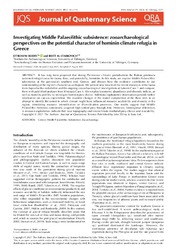Investigating Middle Palaeolithic subsistence: zooarchaeological perspectives on the potential character of hominin climate refugia in Greece
DOI: https://doi.org/10.1002/jqs.3371
Persistent URL: http://resolver.sub.uni-goettingen.de/purl?gldocs-11858/9839
Persistent URL: http://resolver.sub.uni-goettingen.de/purl?gldocs-11858/9839
Roditi, Effrosyni; Starkovich, Britt M., 2021: Investigating Middle Palaeolithic subsistence: zooarchaeological perspectives on the potential character of hominin climate refugia in Greece. In: Journal of Quaternary Science, Band 37, 2: 181 - 193, DOI: 10.1002/jqs.3371.
 |
Dokument öffnen: |
It has long been proposed that during Pleistocene climatic perturbations the Balkan peninsula sustained refugial areas for fauna, flora, and potentially, hominins. In this study, we explore Middle Palaeolithic subsistence at the peninsula's southern end, Greece, and discuss how the evidence contributes to our understanding of the region's character as a refugium. We present new data from the recent reanalysis of the fauna from Asprochaliko rockshelter and the ongoing zooarchaeological investigations at Lakonis Cave 1 and compare them with published analyses from Klissoura Cave 1. We employ taxonomic abundance and diversity indices, as well as mortality profiles, to investigate hominin prey choice. Additional taphonomic observations provide further information on carcass exploitation. We examine changes in the faunal composition of the three sites in an attempt to identify the extent to which climate might have influenced resource availability and diversity in the region, stimulating resource intensification or diversification processes. Our results suggest that Middle Palaeolithic hominins consistently acquired high‐ranked prey through time. However, interregional differences in resource exploitation indicate that local topography and microclimate mediated prey choice and availability.
Statistik:
ZugriffsstatistikSammlung:
This is an open access article under the terms of the Creative Commons Attribution‐NonCommercial‐NoDerivs License, which permits use and distribution in any medium, provided the original work is properly cited, the use is non‐commercial and no modifications or adaptations are made.

